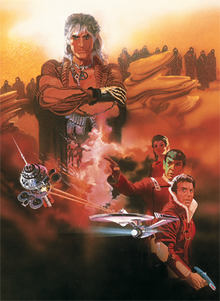
Back Star Trek II: The Wrath of Khan AN ستار تريك 2: غضب خان Arabic Зорны шлях 2: Гнеў Хана Byelorussian Зорны шлях: Гнеў Хана BE-X-OLD Стар Трек II: Гневът на Хан Bulgarian Star Trek 2: La còlera del Khan Catalan Star Trek II: Khanův hněv Czech Star Trek II: The Wrath of Khan Welsh Star Trek II - Khans hævn Danish Star Trek II: Der Zorn des Khan German
| Star Trek II: The Wrath of Khan | |
|---|---|
 Theatrical release poster art by Bob Peak | |
| Directed by | Nicholas Meyer |
| Screenplay by | Jack B. Sowards |
| Story by |
|
| Based on | Star Trek by Gene Roddenberry |
| Produced by | Robert Sallin |
| Starring | |
| Cinematography | Gayne Rescher |
| Edited by | William Paul Dornisch |
| Music by | James Horner |
Production company | |
| Distributed by | Paramount Pictures |
Release date |
|
Running time | 113 minutes[1] |
| Country | United States |
| Language | English |
| Budget | $12 million[2][3] |
| Box office | $97 million[4] |
Star Trek II: The Wrath of Khan is a 1982 American science fiction film directed by Nicholas Meyer and based on the television series Star Trek. It is the second film in the Star Trek film series following Star Trek: The Motion Picture (1979), and is a sequel to the television episode "Space Seed" (1967). The plot features Admiral James T. Kirk (William Shatner) and the crew of the starship USS Enterprise facing off against the genetically engineered tyrant Khan Noonien Singh (Ricardo Montalbán). When Khan escapes from a 15-year exile to exact revenge on Kirk, the crew of the Enterprise must stop him from acquiring a powerful terraforming device named Genesis. The film is the beginning of a three-film story arc that continues with the film Star Trek III: The Search for Spock (1984) and concludes with the film Star Trek IV: The Voyage Home (1986).
After the lackluster critical response to the first film, series creator Gene Roddenberry was forced out of the sequel's production. Executive producer Harve Bennett wrote the film's original outline, which Jack B. Sowards developed into a full script. Director Nicholas Meyer completed its final script in twelve days, without accepting a writing credit. Meyer's approach evoked the swashbuckling atmosphere of the original series, referring to the film as "Horatio Hornblower in space", a theme reinforced by James Horner's musical score. Leonard Nimoy had not intended to have a role in the sequel, but was enticed back on the promise that his character would be given a dramatic death scene. Negative test audience reaction to Spock's death led to significant revisions of the ending over Meyer's objections. The production team used various cost-cutting techniques to keep within budget, including using miniature models from past projects and reusing sets, effects footage, and costumes from the first film. The film was the first feature film to contain a sequence created entirely with computer graphics.
Star Trek II: The Wrath of Khan was released in North America on June 4, 1982, by Paramount Pictures. It was a box office success, earning US$97 million worldwide and setting a world record for its first-day box office gross. Critical reaction to the film was positive; reviewers highlighted Khan's character, Meyer's direction, improved performances, the film's pacing, and the character interactions as strong elements. Negative reactions focused on weak special effects and some of the acting. The Wrath of Khan is considered by many to be the best film in the Star Trek series, and is often credited with renewing substantial interest in the franchise.
- ^ "Star Trek II — The Wrath of Khan (A) (Cut)". British Board of Film Classification. June 16, 1982. Archived from the original on April 19, 2013. Retrieved February 26, 2013.
- ^ Star Trek II: The Wrath of Khan at the American Film Institute Catalog
- ^ Harmetz, Aljean (November 2, 1986). "New 'Star Trek' plan reflects symbiosis of TV and movies". The New York Times. Archived from the original on November 12, 2017. Retrieved March 16, 2020.
- ^ Eller, Claudia (December 11, 1998). "Lower Costs Energize 'Trek' Film Profits". Los Angeles Times. Archived from the original on November 18, 2020. Retrieved May 21, 2020.
© MMXXIII Rich X Search. We shall prevail. All rights reserved. Rich X Search